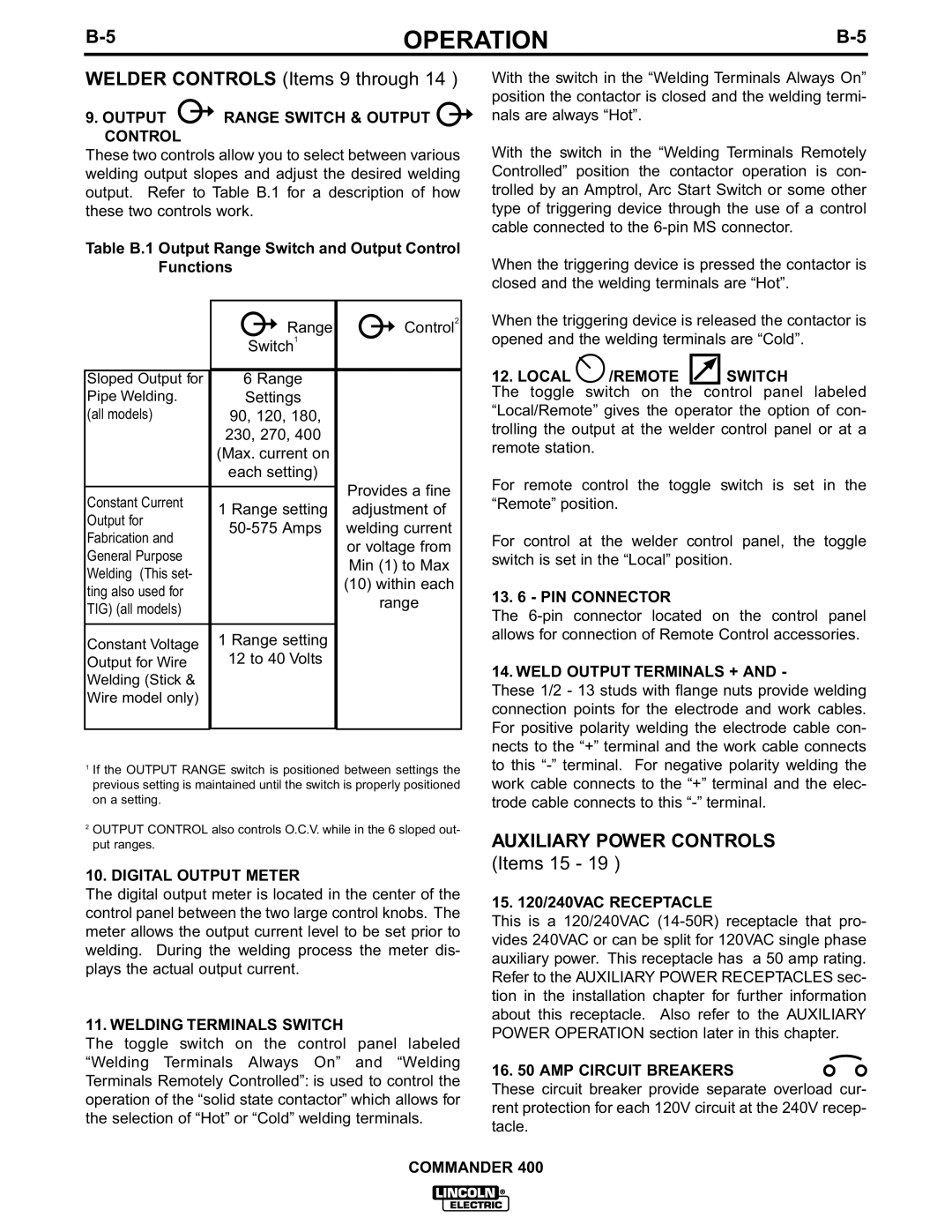
OPERATION | ||
|
|
|
WELDER CONTROLS (Items 9 through 14 )
9.OUTPUT  RANGE SWITCH & OUTPUT
RANGE SWITCH & OUTPUT  CONTROL
CONTROL
These two controls allow you to select between various welding output slopes and adjust the desired welding output. Refer to Table B.1 for a description of how these two controls work.
Table B.1 Output Range Switch and Output Control Functions
| Range | Control2 | |
| Switch1 |
| |
|
|
| |
Sloped Output for | 6 Range |
| |
Pipe Welding. | Settings |
| |
(all models) | 90, 120, 180, |
| |
| 230, 270, 400 |
| |
| (Max. current on |
| |
| each setting) | Provides a fine | |
|
| ||
Constant Current | 1 Range setting | ||
adjustment of | |||
Output for | |||
welding current | |||
Fabrication and | |||
| or voltage from | ||
General Purpose |
| ||
| Min (1) to Max | ||
Welding (This set- |
| ||
| (10) within each | ||
ting also used for |
| ||
| range | ||
TIG) (all models) |
| ||
|
| ||
|
|
| |
Constant Voltage | 1 Range setting |
| |
Output for Wire | 12 to 40 Volts |
| |
Welding (Stick & |
|
| |
Wire model only) |
|
| |
|
|
|
1If the OUTPUT RANGE switch is positioned between settings the previous setting is maintained until the switch is properly positioned on a setting.
2OUTPUT CONTROL also controls O.C.V. while in the 6 sloped out- put ranges.
10. DIGITAL OUTPUT METER
The digital output meter is located in the center of the control panel between the two large control knobs. The meter allows the output current level to be set prior to welding. During the welding process the meter dis- plays the actual output current.
11. WELDING TERMINALS SWITCH
The toggle switch on the control panel labeled “Welding Terminals Always On” and “Welding Terminals Remotely Controlled”: is used to control the operation of the “solid state contactor” which allows for the selection of “Hot” or “Cold” welding terminals.
With the switch in the “Welding Terminals Always On” position the contactor is closed and the welding termi- nals are always “Hot”.
With the switch in the “Welding Terminals Remotely Controlled” position the contactor operation is con- trolled by an Amptrol, Arc Start Switch or some other type of triggering device through the use of a control cable connected to the
When the triggering device is pressed the contactor is closed and the welding terminals are “Hot”.
When the triggering device is released the contactor is opened and the welding terminals are “Cold”.
12. LOCAL  /REMOTE
/REMOTE  SWITCH
SWITCH
The toggle switch on the control panel labeled “Local/Remote” gives the operator the option of con- trolling the output at the welder control panel or at a remote station.
For remote control the toggle switch is set in the “Remote” position.
For control at the welder control panel, the toggle switch is set in the “Local” position.
13. 6 - PIN CONNECTOR
The
14. WELD OUTPUT TERMINALS + AND -
These 1/2 - 13 studs with flange nuts provide welding connection points for the electrode and work cables. For positive polarity welding the electrode cable con- nects to the “+” terminal and the work cable connects to this
AUXILIARY POWER CONTROLS
(Items 15 - 19 )
15. 120/240VAC RECEPTACLE
This is a 120/240VAC
16. 50 AMP CIRCUIT BREAKERS ![]()
![]() These circuit breaker provide separate overload cur- rent protection for each 120V circuit at the 240V recep- tacle.
These circuit breaker provide separate overload cur- rent protection for each 120V circuit at the 240V recep- tacle.
COMMANDER 400
